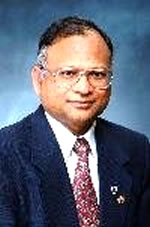 |
Tulane
Engineering Forum
|
|
|
|
|
|
| |
| Opportunities |
| |
| |
| |
| |
Waheed Uddin, Ph.D. Ph.D. in Transportation Engineering, The University of Texas at Austin, 1984. Associate Professor of Civil Engineering and Director of Center of Advanced Infrastructure Technology at the University of Mississippi. First Recipient of 2001 School of Engineering Faculty Service Award. He has conducted over 2 million dollars research projects during the last five year, funded by US DOT, Mississippi DOT, and NASA/ Mississippi Space Commerce Initiative. His recent research involves intelligent transportation systems, nondestructive evaluation, pavement management, bridge cathodic protection, and transportation applications of airborne LIDAR and spaceborne remote sensing technologies.
Dr.
Uddin has made numerous presentations
at national and international
meetings, worked and lectured
on transportation engineering
and management and technology
transfer topics worldwide in
18 countries. He is a coauthor
of "Infrastructure Management,"
published by McGraw-Hill in
August 1997. The Japanese edition
was published in June 2001.
He is a member of the American
Society of Civil Engineers (ASCE)
- Pavements Committee, the ASCE
- FHWA national task group on
the international pavement data
analysis contest, and a Founder
Member of the International
Society for Asphalt Pavements.
He is a member of National Academy
of Sciences-Transportation Research
Board (TRB) Committee A1J07
- Aircraft /Airport Compatibility
and TRB Committee A2A01 - Photogrammetry,
Remote Sensing, Surveying, and
Related Automated Systems. Dr.
Uddin is a Founder and Editor
of IJP - International Journal
of Pavements. Presentation Topic : Remote Sensing Technologies for Highway Corridor Assessment and Pavement Asset Management. By Waheed Uddin, Ph.D.
Remote sensing earth observations from aircraft (airborne) or satellite (spaceborne) offer innovative cost-effective and time saving technologies to assess ground topography and Earth resources by measuring and examining electromagnetic radiation reflected or emitted from the ground surface (and subsurface materials) and provide the data and/or derived information on digital elevation models, condition, and environmental assessment for most transportation and land use planning and engineering studies. The results of a recent study sponsored by NASA/ MSCI and Mississippi DOT are presented that has evaluated data accuracy, efficiency, time saving and cost-effectiveness of the remote sensing LIDAR technology as compared to the conventional ground based methods for terrain data acquisition and mapping. The role and use of remote sensing tunable LIDAR for air quality analysis, a part of the national consortium on remote sensing for environment and sponsored by US DOT, are presented. Integration of these remote sensing and spatial technologies with traditional ground based condition survey methods is discussed for enhanced management of transportation infrastructure and pavement assets. |
 |